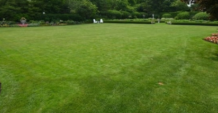If you have tomatoes with a sunken, brown leathery patch on the bottom of the fruit, you probably have blossom end rot. Though most common on tomatoes, blossom-end rot can also affect squash, peppers and watermelons. Not a disease, this condition is caused by a lack of calcium in the developing fruit. It is often assumed that this means there is a corresponding lack of calcium in the soil. This is not necessarily the case, especially in Kansas. Most Kansas soils are derived from limestone, which is partially made up of calcium. So, what causes blossom end rot? Actually, there are a number of possible causes, especially on tomatoes. Let’s look at some of them.
– Tomato tops often outgrow the root system during cooler spring weather. As long as it is cool, the root system can keep up. When it turns hot and dry, the plant has a problem, and water — with the calcium it carries — goes to the leaves and the fruit is bypassed. The plant responds with new root growth and the condition corrects itself after a couple of weeks.
– Heavy fertilization, especially with ammonium forms of nitrogen, can encourage this condition. Heavy fertilization encourages more top than root growth and the ammonium form of nitrogen competes with calcium for uptake.
– Anything that disturbs roots such as hoeing too deep can encourage blossom-end rot. Mulching helps because it keeps the soil surface cooler and therefore a better environment for root growth.
– Inconsistent watering can be a factor. Keep soil moist but not waterlogged. Mulching can help by moderating moisture levels over time. You should also avoid damaging roots and watch fertilization. But there are some years you do everything right and the condition shows up due to the weather. In such cases, remember that blossom-end rot is a temporary condition, and plants should come out of it in a couple of weeks. You may want to pick off affected fruit to encourage new fruit formation.
Soils with adequate calcium will not benefit from adding additional calcium. If your soil is deficient in this nutrient, add 1 pound gypsum per 100 square feet. Gypsum is calcium sulfate and will not affect pH. Though calcium raises pH, sulfate lowers it and the two cancel each other out. Even if not needed, gypsum will not hurt anything.
We have also found that spraying plants with calcium doesn’t work. The fruit’s waxy surface doesn’t allow absorption of the material and calcium does not move from the leaves to the fruit.
Last of all, there are years you can do everything right and still have blossom end rot. As mentioned above, the condition should correct itself in a couple of weeks. (Ward Upham)




